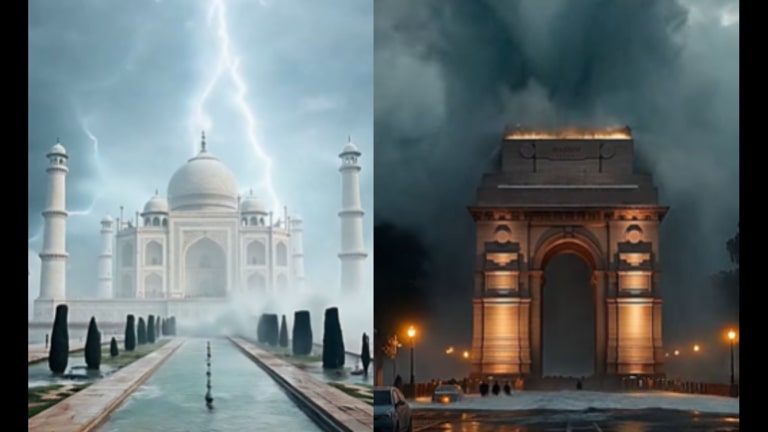AI-Generated Video Shows Tsunami Hitting Taj Mahal, India Gate and Other Iconic Indian Monuments, Shocks Internet
A recently shared AI-generated video has taken the internet by storm, sparking a mix of awe, fear, and fascination among viewers. The video, created using advanced artificial intelligence tools, vividly imagines what it would look like if a massive tsunami were to strike major Indian landmarks—many of which are located in non-coastal cities. The surreal yet terrifying concept has triggered widespread reactions across social media platforms, especially Instagram, where the video was posted by the handle ‘AI.Meme.Nation’.
The clip showcases iconic monuments such as Delhi’s India Gate and Qutb Minar, Agra’s world-famous Taj Mahal, Gujarat’s towering Statue of Unity, and Hyderabad’s historic Charminar, all being engulfed by gigantic waves in a catastrophic tsunami scenario. What makes the video particularly chilling is how realistic the AI-rendered visuals appear, forcing viewers to confront an apocalyptic vision that, while geographically improbable, feels hauntingly real.
As the video gained traction online, reactions poured in from every corner of the internet. Many users described it as terrifying, with some expressing gratitude that they do not reside in coastal areas vulnerable to such natural disasters. One user remarked, “Man this is just so scary. Thank goddess that we do not live in a coastal area or a city,” while another added, “Good thing that this is not possible. Until something extreme happens, like in the 2012 movie. Also, how do you guys even imagine such possibilities?”
Others commented on the technical accuracy—or lack thereof—in the visual representation. A viewer noted, “Qutub Minar can’t survive this because it’s just a tall thing made up of bricks. No clement, no glue, nothing,” while another sarcastically quipped, “WATER PRESSURE SE KUCH GIR NAHIN RAHA BAS,” highlighting the improbability of some structures remaining intact under such extreme conditions.
Despite the fantastical nature of the scenario, the video succeeded in delivering a powerful emotional impact, amplified by the AI’s ability to render hyper-realistic disaster visuals. The conversation it sparked touched not only on the fears of natural calamities but also the broader capabilities—and implications—of AI in visual storytelling. The video prompted reflections on real-world threats faced by coastal cities globally, such as the recent tsunami and earthquake warnings issued in Japan, reminding viewers of the fragility of our environments.
The video’s viral success is a testament to the growing influence of AI in media and content creation. It demonstrates how artificial intelligence can be used not only for entertainment but also for thought-provoking simulations that push the boundaries of imagination and spark meaningful discussion.
For those interested in watching the full AI-generated video and staying updated on similar cutting-edge content, visit our YouTube channel THE OLIGO for exclusive video news and more.

